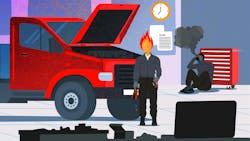Key takeaways:
- Helping diagnostic technicians avoid burnout is key to maintaining shop and fleet efficiency and uptime
- To do so, make sure technicians have the right tools available to them, as well as support from mentors and experts they can call when they get in a bind
In our annual diagnostic supplement, we usually put the focus on the tools used to troubleshoot and resolve issues with your vehicles’ complex systems: which ones you need, how many, and what they can do. This year, however, we wanted to center everything around who uses them. These would, of course, be the diagnostic technicians working for your fleet and at your chosen maintenance providers.
For more on avoiding technician burnout:
You need these people to be at their best more than any one tool, and they are far more valuable and harder to come by. And despite their tough exterior, these experienced shop workers are more difficult to maintain. Sure, you can get them wet and cover them in grease and oil and their processors will work just fine. But you don’t always know when something else can slow them down and burn them out. It could be long hours, or lack of guidance or proper resources.
Burnout is an issue for any manager or employee, but diagnostic techs handle everything from initial scans to the several painstaking hours of troubleshooting to get a problem truck back in service. When these essential workers lose their spark, the whole shop or fleet can flame out.
But how to fix that?
Our most recent diagnostic supplement presents three ways. First, give them the right tools and software. Check if they are happy with their laptop, or if it has any issues that are messing with their rhythm. I know from going way too long with a broken shift key that even minor CPU damage can have severe consequences on productivity. And beyond that, can scan tools infused with AI take them to the next level and ease their cognitive workload? TEXA, for example, has an AI Diagnostic Assist feature that automatically provides repair paths using global scan data.
Then, our resident technician-turned-writer Missy Albin covers how mentoring can light a fire in the apprentice and keep their passion burning for the master. After working with her over the past few years, I doubt an ice age could cool Missy’s love for the job, which she now shares with those she mentors. But never assume that even self-starters have an endless supply of motivation. There were times male colleagues made it hard on her. If not for encouragement from key mentors, things may have turned out differently. So, as a manager, decide wisely who you pair up in these situations.
Finally, there's the best way to ease burnout: asking for help. More specifically, offer a way for diag techs to seek expert opinions and troubleshooting advice from the OEMs and suppliers via a phone call or virtual chat session. These services come at a cost but have been proven to save hours of downtime, helping to ensure your best techs don’t burn all their fuel on a few stressful jobs. They may still want to figure out most problems on their own, but just knowing help is available can make all the difference.
About the Author

John Hitch
Editor-in-chief, Fleet Maintenance
John Hitch is the award-winning editor-in-chief of Fleet Maintenance, where his mission is to provide maintenance leaders and technicians with the the latest information on tools, strategies, and best practices to keep their fleets' commercial vehicles moving.
He is based out of Cleveland, Ohio, and has worked in the B2B journalism space for more than a decade. Hitch was previously senior editor for FleetOwner and before that was technology editor for IndustryWeek and and managing editor of New Equipment Digest.
Hitch graduated from Kent State University and was editor of the student magazine The Burr in 2009.
The former sonar technician served honorably aboard the fast-attack submarine USS Oklahoma City (SSN-723), where he participated in counter-drug ops, an under-ice expedition, and other missions he's not allowed to talk about for several more decades.
